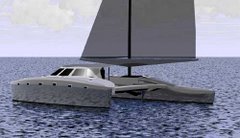Laminating Table
Definitely should have bought that table saw and/or jointer I mentioned last time around. Trying to get a nice straight edge on a 12 foot 2x6 stick with a 3/4 HP Ryobi router was something akin to bringing a knife to a gun fight. Especially since my other bench is an eight footer so each stick needed to be set up twice. Although it took a bit longer to prep the lumber the edges were nice and straight.
I wound up snapping an offset chalk line from one edge, tapping small nails onto the chalkline and then setting the straight edge (I used a 12" section of particle board, very straight edge on the manufactured side) against the nails before screwing into the 2 x 6. Then it was time to let that .75 HP cutting beast of a router work it's magic. A bit of carbide on anything along with a straight fence makes for a decent cutting tool so it all worked out ok.
The plan initially was to use the i-joist used in floors which is a 12" particle board web sandwiched between a couple of 2X2's. Quite pricey and after looking down the edge with a discerning eye it was not as straight as I would have thought.
After prepping the lumber the frame was built to a reference datum that was an imaginary plane established 39" off the floor using monofilament line and a line level. Worked pretty sweet. Was nice having the 3500 pound mill in the area to adjust Z. Being able to adjust anything in .001" increments is always nice although a bit overkill in this case.
Top is 3/4" MDF and it will be finished off with a lovely bit of formica in a couple weeks as soon as it arrives. Options were to cut and paste three 4x8's and deal with the seams (which often seem to be a source of vacuum leaks) or to go with one sheet of 5x10 and a two week lead time. The virtuous option won out here. Measuring out afterwards it apears that the surface is flat within 3/32". Not perfect but adequate over a 10' surface. That's less than .001" per inch. Feeling good about that.
I took a bit of extra time getting the table as flat as possible for a couple reasons. The first nd most obvious reason being that I wanted flat parts. The second was that I viewed this as a good warm-up for building the strong back which will be built using the same methods. This was my first attempt at building to an elevated datum instead of upside down on a concrete slab (our slab is more warped than Mark Foley in a high school internet cafe).
Even though these intial projects aren't putting the flavor of a Pina Colada into the gullet they are rewarding and feel like the type of projects that build skills. I'd rather play around with straight and true on a bench than on a hull.
Next...On to the rudders (I mean it this time)..
